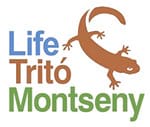Slider 5
Life Tritó Montseny
Un símbol de la natura del Montseny
Subbanner
LIFE15 NAT/ES/000757
Project of conservation of an only species to the world
Breadcrumb
Preparatory actions
Progress of actions A:
100%
Actions A. Preparatory actions, preparation of management plans and/or action plans
A.1. Management and improvement of the captive breeding programme for the Montseny newt: genetic evaluation
Operational objective 1: To widen the geographical distribution of the Montseny newt and ensure its genetic conservation.
The aim of the action is to assess the genetic diversity of the breeding programme in successive generations, to verify the pedigree of all individuals and to genetically optimise reintroductions.
The action will provide effective data on the genetic variability of the captive population and reintroduced specimens using molecular markers. Genetic evaluation allows resolving the unknown pedigree of individuals bred in captivity to reduce the risk of endogamic depression and design optimal breeding plans to ensure the conservation of maximum genetic variability of the species. It also makes it possible to genetically optimise reintroductions by studying minimum viable populations capable of guaranteeing their long-term survival.
Photo: Daniel Guinart.
A.2. Management and improvement of the Montseny newt captive breeding programme: identification of possible causes of bone tissue abnormalities and study of sperm quality.
Operational objective 1: Expand the geographical distribution of the Montseny newt and ensure its genetic conservation
The aim of the action is to increase the production of fertile eggs for the improvement of the breeding programme. The aim of the action is also to improve the reproductive and osteological health of the animals born and kept in captivity.
In the breeding programme for the Montseny newt (Calotriton arnoldi) carried out in recent years at the Torreferrusa Wildlife Centre, high larval mortality has been detected in the early stages of embryonic development, as well as a total absence of descendants from parents born in captivity. Previous studies have been successful in obtaining viable descendants from females bred in captivity paired with wild males. These early results suggest that captive breeding conditions, in this case for males, may affect sperm quality. In this project, the aim is to evaluate whether sperm quality is the main factor causing the absence of descendants, in order to take the necessary measures to solve the problem.
The skeletal-time-based study carried out on the founders of the breeding program, of wild origin and kept in captivity for 3 years prior to the study, has shown problems in terms of bone tissue (e. g. lower bone density compared to wild individuals). Bone malformations have also been observed in some specimens born in captivity that could be the consequence of an inadequate substrate to the facilities or cause nutritional deficiencies. The aim is to assess the possible causes and their solutions.
Montseny newt eggs. Photo: Francesc Carbonell
A.3. Management and improvement of the captive breeding programme for the Montseny newt: technical development of naturalised aquariums
Operational objective 1: Expand the geographical distribution of the Montseny newt and ensure its genetic conservation
The purpose of the action is to condition aquariums that have the same abiotic conditions (temperature, ambient humidity and lighting) that exist in the natural environment and that reproduce the same daily and seasonal variations that are taking place in Montseny. These naturalized aquariums will make it possible to simulate the current environmental conditions and also different climatic scenarios, which will allow assessing the possible effects of climate change on the survival of the Montseny newt population.
Photo: Fèlix Amat.
A.4. Management and improvement of the captive breeding programme for the Montseny newt: information from Life Triton Montseny to potentially involved private owners
Operational objective 2. Increase the hydrological quality of streams and their ecological flow in their distribution area
Operational objective 3. Eliminate or minimize threats to the riverside habitat that currently occupies the area
The purpose of this preparatory action is to inform the owners of the areas where the Life Triton Montseny will be carried out about the project's objectives and the actions planned to achieve them in four years. The final objective of this action is to obtain the property's permissions to execute the proposed actions and at the same time add synergies and means to improve the habitat conditions of the Montseny newt, during the Life Triton Montseny and once completed.
Photo: Fèlix Amat.










